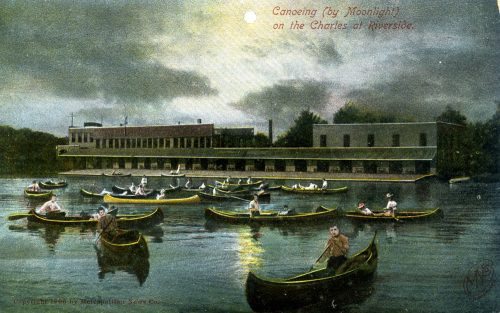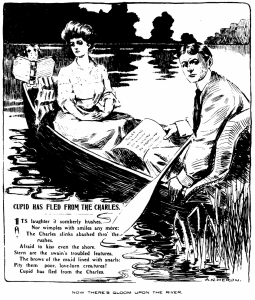
In 1814, the Boston Manufacturing Company dammed the Charles River at Waltham, around 10 miles west of Boston. The construction of the Waltham dam created a scenic network of waterways, popular with holidaymakers and day trippers.
By the turn of the 20th century, the Charles River lakes had become Boston’s own ‘Lover’s Lane’. Hundreds of young couples caught trains or streetcars to the riverside area of Newton, where they could hire canoes from numerous boathouses. Once on the water, it was not difficult to find seclusion in the many creeks, coves and wooded inlets.
Most used this solitude to court without the glaring oversight of parents. The more daring couples used their canoe time as an opportunity to sit close, kiss, pet and whatever else took their fancy.
As might be expected, the interest in canoeing exploded, particularly among young middle-class Bostonians. A state report from January 1903 said the number of canoes on the Charles had increased from 700 to 3,500 in just two years. On warm moonlight nights, there could be as many as 100 canoes still on the water, hours after dark.
According to the Boston Post, a local Baptist minister told his flock not to allow their children onto the lakes, warning that “if these canoes could speak, what awful tales they would tell!”. One park ranger told the press:
“It is not a very nice spectacle to see a couple of opposite sexes lying in the bottom of a boat with a blanket thrown over them.”

In August 1903, the state’s Metropolitan Parks Commission (MPC) moved to crack down on canoe canoodling. New regulations prohibited “any obscene or indecent act” in the confines of the Charles River reserve. In practice, this meant that couples of the opposite sex could not kiss, embrace, lay down in their canoe or conceal themselves or their actions.
Park rangers flooded the area in the summer of 1903 and a local man became the first to fall foul of the MPC’s prophylactic regulations:
“No longer will the young man with the white ducks and canvas shoes be permitted to hold the paddle with one hand and the waist of his best girl with the other… Recently the park commissioners decided that an arm around the waist, a kiss stolen on the sly or a parasol so held that those nearby could not see the faces of the occupants constituted an offence punishable by a fine… In the quiet shade of a giant tree, as their canoe skated slowly in the water, Matthew Petersen of Dorchester improved the occasion to plant a kiss upon the lips of Miss Flora Smith of New York, the couple was arrested.”
Mr Petersen was fined $20 and a handful of others were also arrested. These events sparked a month of protest by Charles River canoeists, who defied the “sit up straight” regulations by laying down in their boats whenever they spotted a park ranger. Despite these protests, the MPC’s crackdown on canoe fornication continued the following season. There were eight arrests for indecency in 1904 and seven in 1905, before arrests declined in subsequent years.
Sources: Metropolitan Parks Commission report, January 1905; Boston Post, August 18th 1903; Palestine Daily Herald, September 9th 1903. Content on this page is © Alpha History 2019-23. Content may not be republished without our express permission. For more information please refer to our Terms of Use or contact Alpha History.
